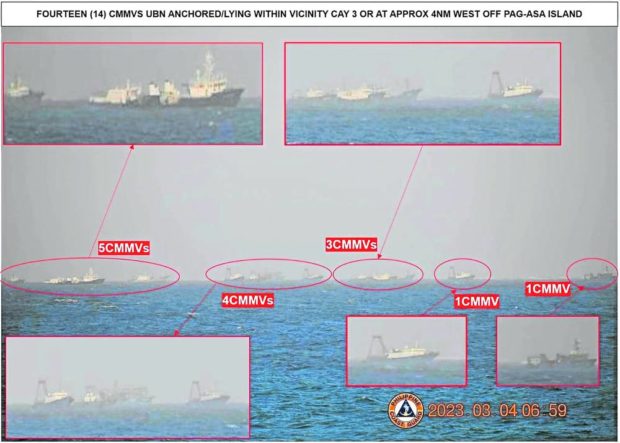Stanford-based project to keep exposing China’s activities in WPS

‘THE WORLD WILL SEE’ | The Philippine Coast Guard (PCG) on Saturday spotted more than 40 Chinese maritime militia vessels anchored within waters near Pag-asa (Thitu) Island in Palawan province. (Photo from the Philippine Coast Guard)
MANILA, Philippines — An emerging project based in an American university aims to shed light on China’s so-called gray zone activities in the West Philippine Sea (WPS), amid its continuing incursions into the country’s exclusive economic zone (EEZ).
Currently being developed at Stanford University’s Gordian Knot Center for National Security Innovation is Project “Myoushu”—or “inspired move”—which refers to a move in the Chinese board game Go that turns a game around.
The project has been tracking activities of Chinese vessels while its head, retired US Air Force Col. Raymond Powell, would tweet satellite images every now and then to “light up on the maritime gray zone,” he said.
On the Project Myoushu page of the Gordian Knot Center’s website, China’s “island-building campaign” and “aggressive employment of [its] paramilitary force” are described as among its “gray zone tactics.”
“Through rapid militarization and escalation, China intimidates and coerces its neighbors and constrains their access to resources within their own lawful exclusive economic zones, often using the opacity and deniability of its gray zone tactics to asymmetric advantage,” Project Myoushu said.
Article continues after this advertisement“The effect has been to significantly undermine US credibility, its network of partners and allies, and its Free-and-Open Indo-Pacific Strategy,” it added.
Article continues after this advertisement‘Pernicious problem’
In an interview with the Inquirer, Powell said “China likes the gray zone because it’s gray. Gray zone means it’s opaque. It’s not clear, it’s deniable, so they can do things in the gray zone and, by and large, the public doesn’t know about it.”
He said the project aims to use the “best technology available in the public sphere” to expose China’s maritime activities.
“We focused primarily on the Philippines [because] it’s a treaty ally. It has a very pernicious problem, which is the fact that China has bases in the Philippines’ EEZ. So it seems like a logical place to start,” Powell said.
He noted that “governments“ like Manila and Washington “are not very good at releasing information,” adding that it could take them “too many steps” to release such data.
“When governments don’t release that information, they don’t expose the gray zone activity, and China thrives in that environment …. So we have been developing this idea we call SeaLight,” Powell said, referring to a concept of Project Myoushu which may be developed into a program for further monitoring of China’s ships.
‘Bully’s game’
He said that, with proper funding, the program could make use of the best available data from commercial ship trackers to publicize gray zone activities.
Powell commended the Philippines’ recent efforts in exposing the presence of Chinese vessels in its EEZ, including the laser-flashing incident early in February.
“Transparency deters the bad actor,” he said.
“Now that the Philippines is saying that it’s done playing the bully’s game, … if China wants to swarm vessels, harass fisherfolk or point lasers, the world will see and hear the proof,” Powell said.
Workshop on sanctions
Meanwhile, several countries with disputes with China, including the Philippines, recently had their customs, coast guard, and legal personnel take part in a workshop by the US Embassy on the enforcement of sanctions on China.
Washington has imposed several sanctions in recent years, among the most recent being the restrictions set by US President Joe Biden on the supply of chips and other computer parts to Beijing.
But China has been able to skirt these sanctions through its sheer predominant role in seaborne trade, among other advantages.
Government staff from the Philippines, Indonesia, Vietnam, and Taiwan joined the workshop organized by the US Embassy’s Export Control and Border Security (EXBS) program at an undisclosed venue in Manila.
“The workshop and relationships developed will provide contacts for future collaboration and cooperation,” EXBS Regional Advisor Ransom Avilla said of the three-day forum which ended on March 2.
—WITH A REPORT FROM JACOB LAZARO
RELATED STORIES
DND: After China laser attack, US assures PH of ‘ironclad commitment’ on alliance
DFA chief: China harassment a ‘daily situation’ for PH
‘Welcome to China’ greets PCG aircraft over Ayungin
For comprehensive coverage, in-depth analysis, visit our special page for West Philippine Sea updates. Stay informed with articles, videos, and expert opinions.